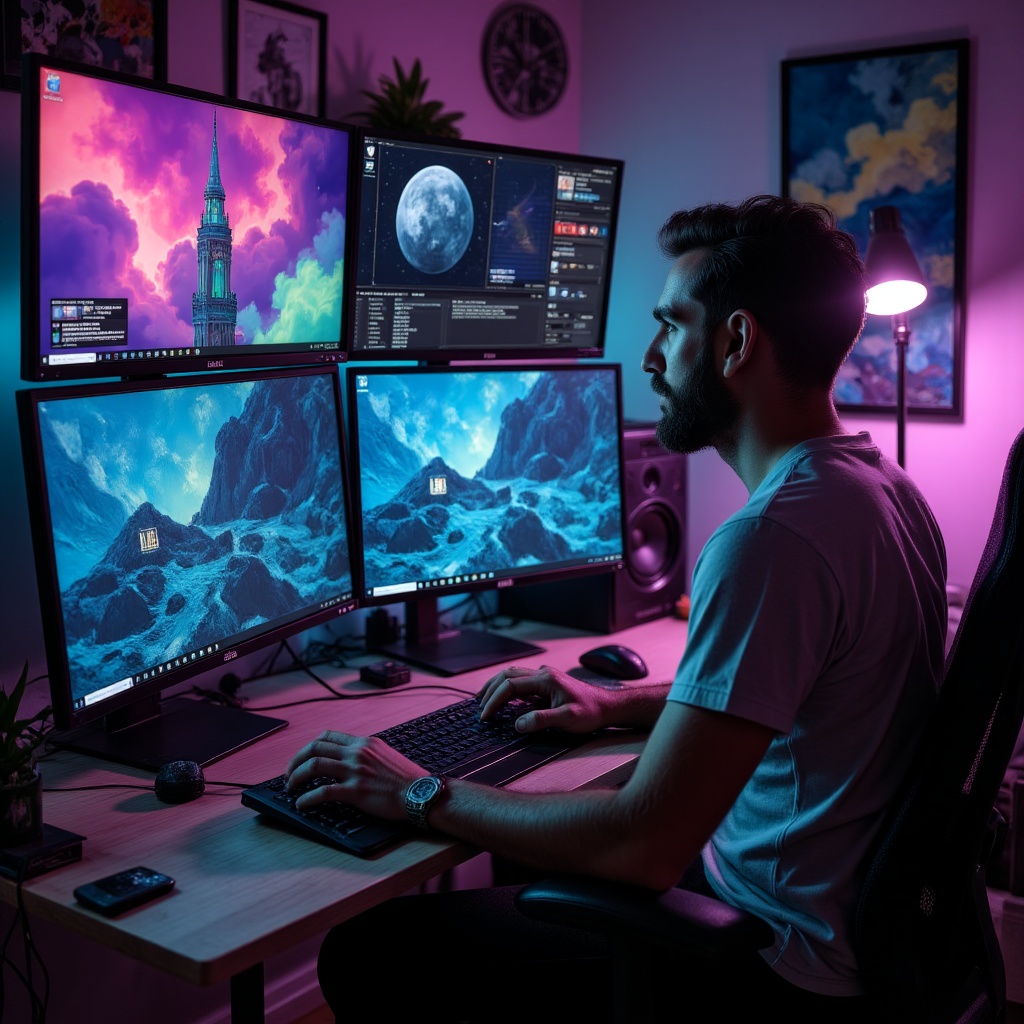-
How Personal Technology Habits Shape Your Lifestyle: A Deep Dive into Digital Living

The alarm on your smartphone wakes you. You check notifications before getting out of bed. Your smartwatch tracks your morning run. You scan a QR code for coffee payment. You attend virtual meetings, order dinner through an app, and stream entertainment before bed. This is the reality of modern life—a seamless integration of technology into every moment of our existence.
Personal technology habits have become the invisible architecture of contemporary lifestyle. These digital patterns don't merely supplement our daily routines; they fundamentally reshape how we work, socialize, maintain health, manage finances, and perceive the world around us. Understanding this relationship has never been more critical as we navigate an increasingly connected future.
The Morning Routine Revolution: How Technology Sets Your Daily Tone
The first thirty minutes after waking establish the psychological framework for your entire day. Technology has transformed this sacred window into a battleground between intentional living and reactive scrolling. The habit of checking your phone immediately upon waking triggers a cascade of neurochemical responses that influence mood, focus, and decision-making throughout the day.
Studies indicate that individuals who begin their day with screen time experience heightened stress levels and reduced cognitive performance. Conversely, those who use technology mindfully—perhaps engaging with meditation apps, fitness trackers for morning exercise, or educational podcasts—report improved mental clarity and emotional stability. This dichotomy illustrates a fundamental principle: technology itself is neutral, but our habits surrounding its use carry profound consequences.
Smart Home Integration and Mental Space
Voice-activated assistants, automated lighting systems, and smart thermostats have redefined the concept of home environment. These technologies reduce decision fatigue by automating routine choices, freeing mental resources for more meaningful activities. However, the constant connectivity can also blur boundaries between work and personal life, creating an always-on mentality that erodes relaxation and recovery time.
Digital Health Tracking: The Quantified Self Movement
Wearable technology has transformed health management from an abstract concept into a data-driven practice. Fitness trackers, smartwatches, and health monitoring apps provide unprecedented insight into physical activity, sleep patterns, heart rate variability, and even blood oxygen levels. This quantification of wellness has created a new paradigm in preventive healthcare.
The habit of regular health tracking correlates with improved fitness outcomes, better sleep hygiene, and increased awareness of nutritional choices. Users who consistently engage with their fitness data demonstrate higher adherence to exercise routines and dietary goals. The immediate feedback loop—seeing steps counted, calories burned, or sleep quality scores—creates a gamification effect that motivates sustained behavioral change.
Mental Health Applications and Emotional Wellness
Beyond physical metrics, technology has ventured into the realm of mental wellness. Meditation apps, mood trackers, and digital therapy platforms have democratized access to mental health resources. These tools help users identify emotional patterns, practice mindfulness, and develop coping strategies for stress and anxiety.
The habit of daily mental health check-ins through apps can increase emotional intelligence and self-awareness. However, experts caution against using technology as a complete replacement for professional mental health care. The most effective approach combines digital tools with traditional therapeutic relationships when needed.
Work Productivity and the Remote Revolution

Technology habits have radically altered professional life, particularly following the global shift toward remote and hybrid work models. The tools we use daily—project management platforms, communication apps, cloud storage systems—fundamentally shape our productivity patterns and work-life balance.
Individuals who establish clear technology boundaries report higher job satisfaction and lower burnout rates. This includes habits like designated work hours for email, app-based time tracking to prevent overwork, and intentional digital disconnection after business hours. Conversely, the habit of constant availability—enabled by smartphones and messaging apps—correlates with increased stress, reduced sleep quality, and diminished personal relationship satisfaction.
The Pomodoro Technique Meets Digital Tools
Productivity apps incorporating focus timers, distraction blockers, and task prioritization systems have become essential for knowledge workers. The habit of structured work sessions, tracked and reinforced through technology, enhances concentration and output quality. These digital tools transform abstract productivity advice into concrete, measurable practice.
Social Connectivity and Relationship Dynamics
Perhaps no aspect of lifestyle has been more profoundly affected by technology habits than social relationships. Communication platforms, social media networks, and video calling applications have redefined human connection, creating both opportunities and challenges for meaningful interaction.
The habit of maintaining digital communication with distant friends and family strengthens relationships across geographical boundaries. Video calls enable face-to-face interaction that was impossible a generation ago. However, the same technologies can undermine local relationships when screen time replaces in-person engagement.
The Social Media Paradox
Social media habits illustrate technology's double-edged nature. Moderate, intentional use facilitates community building, information sharing, and creative expression. Excessive, passive scrolling correlates with increased loneliness, anxiety, and social comparison. The critical factor lies not in the platforms themselves but in how we habitually engage with them.
Users who curate their digital environments—unfollowing accounts that trigger negative emotions, setting time limits, and engaging actively rather than passively consuming—report more positive experiences. The habit of conscious consumption transforms social media from a source of distress into a tool for genuine connection.
Financial Management in the Digital Age
Banking apps, investment platforms, and cryptocurrency wallets have revolutionized personal finance management. The habit of regular financial tracking through digital tools correlates with improved savings rates, reduced debt, and better investment decisions. Real-time access to account balances and spending patterns enables immediate course correction rather than monthly reckoning.
Automated savings features, budget tracking apps, and expense categorization tools remove friction from financial discipline. The technology enables users to set goals, monitor progress, and celebrate milestones—psychological factors crucial for sustained financial health. For cryptocurrency enthusiasts, mobile wallets and trading apps have made digital asset management an integrated part of daily financial routines.
The Rise of Micro-Investing and Financial Education
Investment apps have lowered barriers to entry for stock market participation and cryptocurrency trading. The habit of regular, small investments—facilitated by round-up features and automated contributions—builds wealth incrementally. Educational content integrated into these platforms transforms passive users into informed investors, fundamentally altering their relationship with money and future planning.
Learning and Personal Development
Educational technology has democratized knowledge acquisition beyond traditional institutional boundaries. Online courses, language learning apps, skill-building platforms, and educational podcasts enable continuous personal development tailored to individual schedules and learning preferences.
The habit of daily learning through apps—even just fifteen minutes—compounds into significant skill development over time. Duolingo streaks, Coursera certificates, and podcast subscriptions represent more than digital badges; they reflect a lifestyle oriented toward growth and curiosity. This technological facilitation of learning has created a culture of perpetual students, regardless of age or formal educational background.
Entertainment Consumption and Cultural Engagement
Streaming services, gaming platforms, and digital content libraries have transformed entertainment from scheduled broadcasts to on-demand experiences. This shift empowers individual choice but also enables binge-watching habits that can displace other valuable activities. The technology itself is neutral—the determining factor lies in habitual usage patterns.
Intentional entertainment habits—scheduling specific viewing times, balancing passive consumption with active hobbies, using parental controls or app timers—maintain technology as a source of joy rather than a time sink. The key differentiator between healthy and problematic entertainment technology use lies in conscious choice versus automatic behavior.
Sleep Quality and Evening Technology Habits
Evening technology use represents one of the most impactful habit patterns affecting overall lifestyle quality. Blue light emission from screens suppresses melatonin production, disrupting circadian rhythms and degrading sleep quality. Despite widespread awareness of this issue, many individuals struggle with pre-bedtime screen habits.
Those who establish technology curfews—typically one to two hours before sleep—report improved sleep quality, easier morning waking, and better next-day cognitive function. Sleep tracking apps can paradoxically help by creating awareness of how evening screen time correlates with poor sleep metrics, motivating behavioral change through data visualization.
Environmental Impact and Sustainable Technology Habits
Personal technology habits extend beyond individual well-being to environmental considerations. The energy consumption of constant device charging, the environmental cost of frequent upgrades, and the e-waste generated by discarded electronics all connect personal digital habits to broader ecological impacts.
Sustainable technology habits—extending device lifespan, using energy-efficient charging practices, participating in electronics recycling programs—align personal technology use with environmental values. Apps that track carbon footprint and suggest eco-friendly alternatives integrate sustainability into daily digital routines.
Creating Intentional Technology Habits
The profound influence of technology habits on lifestyle demands intentional habit design rather than passive adoption of default patterns. Digital wellness begins with awareness—tracking current technology use through built-in screen time features or third-party apps provides baseline data for improvement.
Effective strategies include:
- Environmental design: Charging phones outside the bedroom, deleting problematic apps, using website blockers during focus time
- Scheduled technology time: Designated periods for social media, email, and entertainment rather than constant access
- Replacement habits: Substituting screen time with physical activities, face-to-face socializing, or creative pursuits
- Regular audits: Periodic assessment of which apps and devices genuinely improve life quality versus those that drain time and energy
- Mindful consumption: Asking whether technology use serves intentional goals or represents automatic behavior
The Future of Personal Technology Integration
Emerging technologies promise even deeper integration into lifestyle patterns. Augmented reality, artificial intelligence assistants, brain-computer interfaces, and advanced health monitoring will create new opportunities and challenges for intentional living. The fundamental principle remains constant: technology amplifies existing habits, making conscious choice increasingly critical.
As virtual reality becomes more accessible, the boundary between digital and physical experience will further blur. Cryptocurrency and blockchain technologies are reshaping financial habits and concepts of ownership. The individuals who thrive in this evolving landscape will be those who cultivate awareness of their technology habits and align digital behavior with core values and life goals.
Conclusion: Technology as Lifestyle Amplifier
Personal technology habits shape lifestyle not through deterministic control but through incremental influence repeated thousands of times. Each notification response, app opening, and digital interaction represents a micro-choice that collectively defines daily experience. The power lies not in rejecting technology but in curating habits that harness digital tools for genuine enhancement rather than distraction.
The most successful technology users in terms of lifestyle quality are not necessarily minimalists or maximalists but intentionalists—individuals who thoughtfully design their digital habits to support health, relationships, productivity, learning, and well-being. As technology continues evolving at an accelerating pace, this capacity for conscious habit formation becomes the defining skill for thriving in the digital age.
Your smartphone, smartwatch, and laptop are neither enemies nor saviors. They are powerful tools whose impact depends entirely on the habits you build around them. The lifestyle you desire begins with the technology habits you practice today.